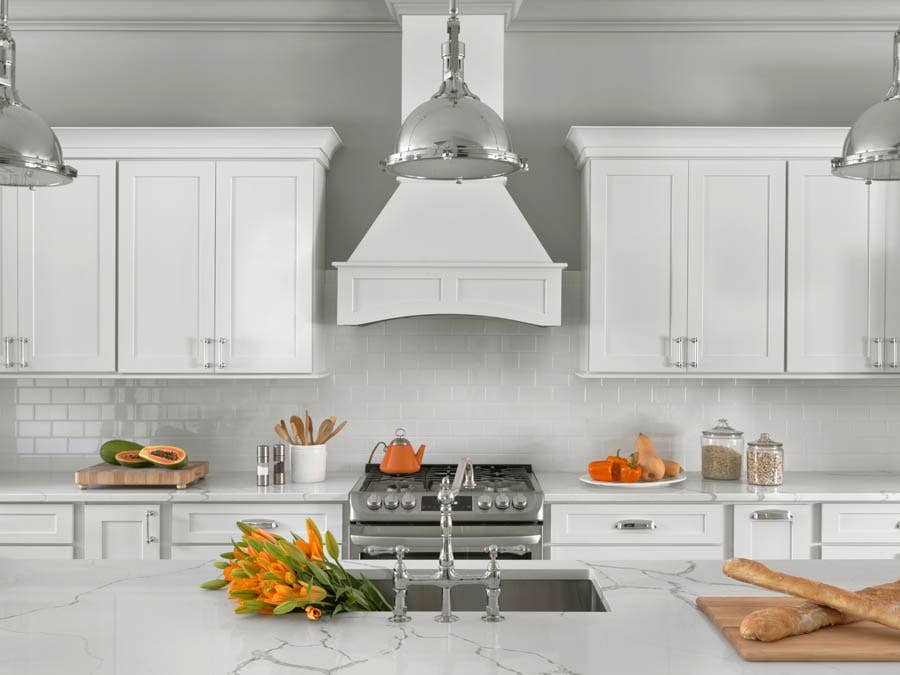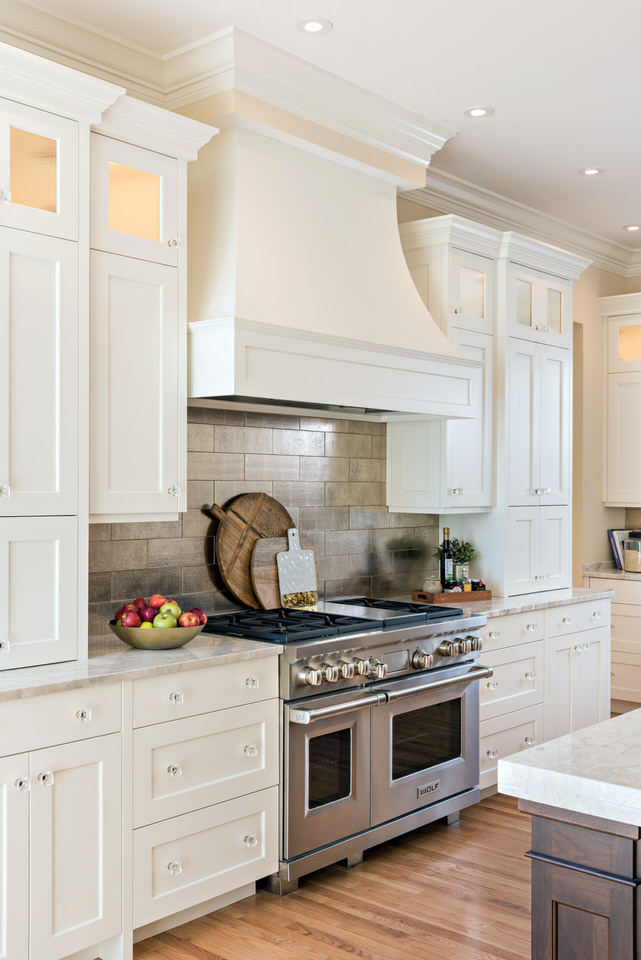A kitchen range hood is a device that sits above your cooking area and helps to keep your home free of airborne contaminants and odors. Range hoods come in a variety of designs and can be either wall-mounted or ceiling-mounted. They can also be vented to the outside or recirculated, depending on your needs. Range hoods provide ventilation to remove smoke, steam, and odors, as well as help keep your kitchen and home free of airborne grease, smoke, and other airborne particles.
Types of Kitchen Range Hoods
When it comes to kitchen range hoods, there are several types to choose from that can provide functional and aesthetic benefits to your kitchen. Each type of kitchen range hood has its unique features and advantages. Depending on the size of your kitchen and your desired look, one type of range hood might be better suited for you than another. Common types of kitchen range hoods include wall-mounted range hoods, island range hoods, downdraft range hoods, and under-cabinet range hoods.
Wall-mounted range hoods are the most common type of range hood and are mounted directly to the wall above the stove. They provide efficient ventilation and can be installed anywhere there is an appropriate venting system. Island range hoods, on the other hand, are suspended from the ceiling and are typically used in kitchens with an island cooktop. Downdraft range hoods, like island range hoods, are suspended from the ceiling but are placed in the center of the kitchen. Under-cabinet range hoods are installed directly under the kitchen cabinet and provide ventilation without taking up valuable wall or ceiling space.
Each type of range hood has its unique benefits and drawbacks, so it’s important to consider all of your options when deciding which type of range hood is best for your kitchen. Ultimately, the right range hood for your kitchen will depend on the size of your kitchen, the type of cooktop you have, and the style of your kitchen.
Benefits of Installing a Range Hood
A range hood is an essential appliance that is installed above a kitchen cooker or stovetop. It is designed to remove smoke, odor, and other airborne pollutants from the air in your kitchen. Installing a range hood offers several benefits to your kitchen and your home in general.
First, a range hood helps to reduce the amount of smoke and other pollutants in your kitchen. This helps to reduce the risk of fires and also improves the air quality in your kitchen. Additionally, a range hood can help to reduce kitchen odors, making your kitchen more pleasant and inviting.
Second, a range hood can help to reduce the amount of heat in your kitchen. This can be especially beneficial in the summer months when the temperature in your kitchen can often be quite high. By reducing the amount of heat in your kitchen, you can make it much more comfortable and enjoyable for cooking and entertaining.
Third, a range hood can help to improve the overall aesthetic of your kitchen. Range hoods come in a variety of styles and finishes, so you can find one that perfectly suits your kitchen and adds a touch of sophistication and style.
Overall, installing a range hood in your kitchen offers several benefits, including improved air quality, reduced heat, and improved aesthetics. So, if you’re looking to upgrade your kitchen, installing a range hood is a great option.
Installation Considerations for Range Hoods
Installing a kitchen range hood is a great way to improve air quality in your cooking area. But before you embark on this project, there are a few things to consider. First, you’ll need to decide what type of range hood you want. Wall-mounted range hoods are the most common type and are ideal for kitchens with limited space. Island range hoods, on the other hand, are larger and more powerful, and are perfect for larger, more open kitchen spaces.
Next, you’ll need to consider the size and style of the range hood. If you’re replacing an existing hood, take measurements of the existing hood and check the manufacturer’s recommendations for the size and style of hood that will best suit your needs. You’ll also need to select a hood that’s the right size for your cooking space; if the hood is too small, it won’t be able to provide adequate air circulation.
Finally, you’ll need to decide how the range hood will be vented. Some range hoods are vented directly outdoors via a duct system, while others are ductless and use a filter to capture cooking odors and smoke. Depending on the type of range hood you select, you may need to hire a professional to install it. This is especially true for ducted range hoods, as the ductwork must be installed correctly for optimal performance.
No matter what type of range hood you choose, it’s important to make sure it’s installed correctly for optimal performance and safety. Consider the size, style, and ventilation of the range hood before you begin your installation project.

Maintenance and Cleaning of Range Hoods
Maintaining and cleaning your kitchen range hood is essential for effective performance and a safe kitchen. Range hoods remove smoke, grease, and other airborne particles from the air, eliminating odors and keeping your kitchen fresh. Cleaning the hood regularly is the best way to ensure it can do its job properly and to keep your kitchen safe and comfortable.
When cleaning your range hood, start with the filters. The filters should be removed and cleaned with warm, soapy water, or in the dishwasher for metal filters. You should also check the grease collector, if your range hood has one, and clean it regularly. Make sure to clear away any dust and debris, and replace the filters when they are clean.
You should also inspect the wiring and connections of the range hood. Check for any worn or damaged components, and replace them if necessary. Make sure all connections are secure and that the hood is properly grounded.
Finally, it is important to clean the outside of the range hood, including the fan, its housing, and the vent duct, to ensure it looks its best. Make sure to use only non-abrasive cleaners, and to avoid cleaning the hood when it is still hot.
Regular maintenance and cleaning of your kitchen range hood will ensure that it can work effectively and safely, and will keep your kitchen fresh and inviting.
Troubleshooting Common Range Hood Problems
No matter how well-maintained your kitchen range hood is, sometimes it can still have issues. If your range hood is not working properly or making strange noises, it can be frustrating and make cooking less enjoyable. To help you identify and rectify common problems, here is a guide to troubleshooting range hoods.
If your range hood is not ventilating your kitchen adequately, the most common cause is a clogged filter. Cleaning the filter regularly and checking it for blockages can help prevent this problem. Additionally, make sure that the fan is running at the correct speed. It should be set to the highest setting to ensure that the hood is working optimally.
If your range hood is making strange noises, it could be an issue with the blower wheel. This is the part of the hood responsible for drawing air up and out of the kitchen. Make sure to inspect the blower wheel for any damage or debris that could be blocking its movement. Additionally, ensure that the motor and fan blades are correctly aligned.
Finally, check to make sure that the hood is properly connected to the duct system and the exhaust pipe. If the connection is not secure, it could cause the hood to be noisy and inefficient. If you are unable to fix the issue on your own, contact a professional range hood technician to help.
By following this guide, you can troubleshoot common range hood problems quickly and easily. With regular maintenance and the knowledge to identify issues, you can ensure that your kitchen range hood is functioning correctly.
Cost of Range Hoods
Range hoods come in all shapes and sizes, and the cost of these appliances can vary greatly. Generally speaking, range hoods range in price from $50 to $2,000 or more. The cost of a range hood will depend on a variety of factors, including the type of hood, the size, the material, and the features. Wall-mounted range hoods are typically more expensive than island range hoods, as they require more installation work. Stainless steel range hoods are usually more expensive than hoods made of other materials, such as aluminum. A range hood with more features, such as LED lights and multiple fan speeds, will also cost more. It’s important to consider your budget when determining which range hood to buy. To ensure the best value, opt for a range hood that offers the features you need without breaking the bank.
Conclusion
A kitchen range hood is an essential appliance for any kitchen. It helps to improve air quality by removing smoke, fumes, and other airborne contaminants, as well as keeping the kitchen looking and smelling fresh. Range hoods come in a variety of styles and sizes and should be chosen based on the size of the kitchen and the type of cooking being done. With the right range hood in place, a kitchen can become a more pleasant place to cook.


